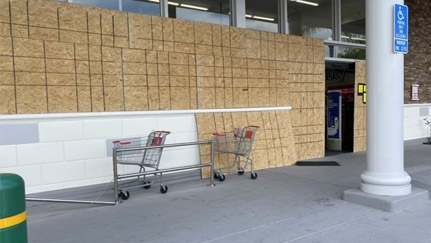Maintain closed or idle buildings during civil unrest

Guidance for minimizing risk to your closed or idle building during a civil unrest event.
Civil unrest events typically evolve from a group of people protesting against major sociopolitical issues though they may also evolve from major sporting events, concerts, or even block parties. Protestors may lash out in a violent way against authority, property, or people. Riots may ensue involving vandalism and the destruction of property with targets varied between public and private properties. Regardless of the terminology, the current era in the U.S. is sometimes marred by occurrences of civil unrest.
Building owners must prepare for these events by formalizing a plan, which may require closing or idling your facility until the event is controlled or alleviated.
An idle, closed or vacant building has significant risks for fire, water damage, freezing, vandalism, mold, crime, vagrant issues, weather-related issues and property theft. In order to help limit the risk of a loss during a civil unrest event that requires an idle period, closure or vacancy, Nationwide Loss Control recommends observing the following procedures:
- Develop an emergency call list to contact your employees in a civil unrest event.
- Check with your agent to go over your relevant insurance coverages.
- Develop and conduct a formal inventory of your building property. Records of this inventory should be kept off site in a safe location.
- Any exterior entrance gates should be closed and locked.
- Notify the local police, as well as the fire department and emergency response teams of the building’s status.
- Provide physical safeguards to doors, and windows, such as metal grating, wood barriers, etc.
- If there is no current guard service or burglar alarm provided, consideration should be given to obtaining an onsite guard service and or a security alarm.
- Consider suspending all mail deliveries or forward the mail to another occupied address.
- Maintenance of the building should continue only when safe. This should include inspecting it for leaks/openings, any water mitigation, noting and repairing any weather-related damage, etc.
- The facility should be visited and inspected when the situation/event allows safe visitation.
During any visitation:
- Inspect exterior of the building for event-related damage, operational lighting, unauthorized entry, and vandalism
- Interior visits should include walkthrough of all areas of the building, confirming that all necessary utilities are in operation, all alarms are in operation, and any fire protection remains in operation. In addition, inspect for any weather-related damage to the interior of the building, such as water, mold, freezing, etc.
- These inspections should be formal with records maintained. A check sheet should be developed with your site-specific inspection procedures and critical items to be checked related to your facility and operations.
- The exterior of the building should continue to be maintained with exterior lighting, general maintenance, grounds keeping, etc. as the situation safely allows.
Vacant, closed or idle facilities due to civil unrest are at a significantly higher risk for a property loss than facilities that are open and in operation. By taking a strategic approach as outlined in the above steps before a facility becomes closed, vacant, or idle the risk of loss can be greatly reduced. Nationwide’s Loss Control Services team is available to provide solutions to help our members manage risks associated with vacant buildings.
More information regarding hazards associated with unoccupied buildings can be found in the following Loss Control Services resources:
